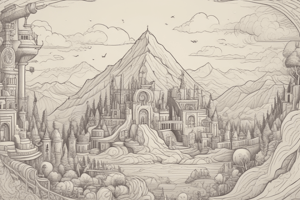Podcast
Questions and Answers
What is the primary focus of the Strategy Plane?
What is the primary focus of the Strategy Plane?
- Defining specific requirements
- Understanding user needs and product objectives (correct)
- Designing the user interface
- Arranging content elements
What is the purpose of the Scope Plane?
What is the purpose of the Scope Plane?
- To arrange content elements
- To design the user interface
- To translate strategy into specific requirements (correct)
- To define the sensory experience
What type of design is used to define how the system behaves in response to the user?
What type of design is used to define how the system behaves in response to the user?
- Information architecture
- Interaction design (correct)
- Navigation design
- Sensory design
What is the primary focus of the Structure Plane?
What is the primary focus of the Structure Plane?
What type of design is used to arrange content elements to facilitate human understanding?
What type of design is used to arrange content elements to facilitate human understanding?
What is the primary focus of the Skeleton Plane?
What is the primary focus of the Skeleton Plane?
What type of design involves arranging interface elements to enable users to interact with the functionality of the system?
What type of design involves arranging interface elements to enable users to interact with the functionality of the system?
What is the primary focus of the Surface Plane?
What is the primary focus of the Surface Plane?
What is included in sensory design?
What is included in sensory design?
How do the five planes relate to each other?
How do the five planes relate to each other?
Flashcards are hidden until you start studying
Study Notes
The user experience design process ensures that no aspect of the user's experience with a product happens by chance. It involves considering the user's every action and expectation.
The process can be broken down into five planes:
- The Strategy Plane: This plane is the foundation of the user experience and involves understanding user needs and product objectives. User needs are the goals that come from the people who will use the site, while product objectives are the business goals or other objectives the organization has for the site.
- The Scope Plane: The scope plane translates the strategy into specific requirements. For functionality-oriented products, the scope is defined through functional specifications (detailed descriptions of the feature set). For information-oriented products, the scope is defined through content requirements (descriptions of the various content elements required).
- The Structure Plane: The structure plane gives form to the scope. For functionality-oriented products, interaction design is used to define how the system behaves in response to the user. For information-oriented products, information architecture is used to arrange the content elements to facilitate human understanding.
- The Skeleton Plane: The skeleton plane further refines the structure, identifying specific aspects of interface, navigation, and information design. Interface design involves arranging interface elements to enable users to interact with the functionality of the system. Navigation design is the set of screen elements that allow the user to move through the information architecture. Information design is the presentation of information in a way that facilitates understanding.
- The Surface Plane: The surface plane is focused on the sensory experience created by the finished product. It involves sensory design, which includes visual design, sound design, and touch design (for touch-interactive devices). Here the content, functionality, and aesthetics come together to produce a finished design that pleases the senses while fulfilling all the goals of the other four planes.
Each plane is dependent on the decisions made on the planes below it. Decisions made on lower planes will affect the choices available on higher planes. However, it's important to note that the decisions on each plane can also influence decisions made on lower planes, creating a back-and-forth process of refinement.
Studying That Suits You
Use AI to generate personalized quizzes and flashcards to suit your learning preferences.




